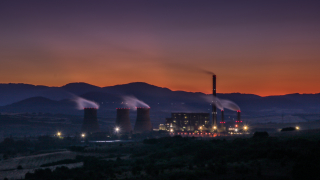Unsplash.com/@viktor-kiryanov
Posted by Todd Moss and Rushaiya Ibrahim-Tanko[1]
Soon after the reformist businessman Hakainde Hichilema won Zambia's presidency in August 2021, he learned that his country’s finances were far worse than he feared. Though Zambia had once been highly indebted, it had received a fresh start from comprehensive debt relief in 2005. Now, sixteen years later, Hichilema discovered the treasury was “literally empty” and an urgent audit found a total of more than $16 billion in external debt, including billions in underreported obligations. Attention from both the media and Zambia’s creditors has largely focused on the more than $6 billion owed to Chinese lenders, about double the amount reported by the previous government. But there’s another source of concern beyond opaque loans or deceptive bookkeeping: undisclosed electricity contracts. Buried in the new accounting of Zambia’s debt is more than $1 billion in unpaid arrears owed to power companies.
Here’s what’s really scary: the power sector arrears reported by Zambia are almost certainly just the tip of the iceberg. Power purchase agreements (PPAs), long-term agreements between utility off takers and private power producers to buy electricity, are the core contracts that allow solar farms, hydroelectric dams, or thermal plants to secure financing. In emerging and frontier markets, PPAs usually come with a sovereign guarantee. This is positive for development because it attracts investment in electricity, which low income, high-risk countries need to grow their economies. But when the utility does not pay, its obligations are assumed by the government and added to the nation’s outstanding debt. Further, when PPAs are later canceled or renegotiated, the government must make payments to investors. Thus, even though PPAs are a form of potential public debt, their terms are rarely disclosed. The listed $1 billion in PPA arrears owed by the Zambian government is only the overdue portion of contracts still unpaid by the treasury. Billions more in hidden debt could be lying inside other PPAs. But without any visibility into the terms of the contracts – who owes whom, how much, and under what conditions – it’s impossible to know what’s looming below the surface.
And Zambia is not alone. More countries are coming under debt distress – from the pandemic, soaring prices for imported food and fuel, and previous overborrowing – so debt restructuring requests are mounting. An estimated 60% of the world’s poorest countries are at high risk or are already in debt distress, including Pakistan, Sri Lanka, Ethiopia, Haiti, and Laos. In many of these cases, power sector finances have played a role.
Faced with chronic blackouts, Ghana’s government signed 43 PPAs between 2011-16. But when a new government came to power in 2017, it found that these contracts were for more power than was necessary. Many contained excess capacity charges forcing the Ministry of Finance to pay about $620 million in 2019 for electricity that the country did not use. Ghana, like Zambia, received a sizable debt relief package in 2005, but now has external debts of about $30 billion. Some $2.7 billion of this debt relates to the power sector, which could rise to $12 billion if nothing is done. In response, the government canceled dozens of contracts and is seeking to renegotiate many more. Yet the basic terms of the contracts, and their potential public sector obligations, are still shielded from the Ghanaian taxpayer.
Pakistan too has seen private power projects become public debt. In 2021, the government paid about $500 million to partially clear PPA arrears, with another $1.7 billion owed. It is now seeking to renegotiate PPAs to reduce costs and avoid further debts.
One obvious answer to preventing this problem in the future is transparency. Just like contracts for oil, mining, and sovereign debt where disclosure is now an accepted norm, power contracts with a direct or indirect sovereign guarantee should be publicly disclosed.
Governments hoping to attract private investment in critical power infrastructure should encourage open markets if they want to receive competitive pricing and avoid future debt burdens. As the push for deploying lots more clean energy gathers momentum, power contracts are especially vulnerable to go awry if they remain undisclosed and their terms secret. Committing to publish contracts – say, one year after financial close – would create powerful incentives for both investors and government officials to negotiate in good faith. Open competitive markets would accelerate the deployment of clean energy by shortening the negotiation time and cleaning out the pipeline of stuck projects. And, perhaps most importantly, transparency would give citizens greater confidence that projects are being agreed in the public interest.
The current debt pressures present an ideal time for the International Monetary Fund and the World Bank to take a stand too. In individual country programs, the Fund regularly identifies PPAs as debt risks, such as in Pakistan’s 2019 agreement, but it should consider contract transparency as another preventative measure. The World Bank is also focused on debt transparency and will play a lead role in any new rounds of debt relief. The Bank also recently published a dire warning about hidden debt from state-owned enterprises and contingent obligations buried in public-private partnerships across South Asia. Its lessons apply globally.
Zambia is now seeking a new round of debt relief, while the IMF and the country’s creditors are insisting on far greater debt transparency. The push for transparency ideally should extend to contingent liabilities concealed in the power sector. When Zambia’s creditors finally come to the table to negotiate a new debt relief plan, a commitment to electricity contract disclosure should be part of the package. Development finance institutions, including the World Bank’s private sector arm, should also embrace contract disclosure. President Hichilema is dedicated to getting his country back on a sustainable financial footing. Welcoming PPA transparency would greatly support that effort – and show his neighbors the path forward to building a competitive market for electricity while creating incentives to avoid future debt crises.
[1] Todd Moss is Director of the Energy for Growth Hub, a nonprofit research network focused on energy in emerging markets. Rushaiya Ibrahim-Tanko is a lawyer based in Accra who leads the Hub’s project on PPA Transparency, which seeks to create global disclosure norms for power contracts.
Note: The posts on the IMF PFM Blog should not be reported as representing the views of the IMF. The views expressed are those of the authors and do not necessarily represent those of the IMF or IMF policy.






